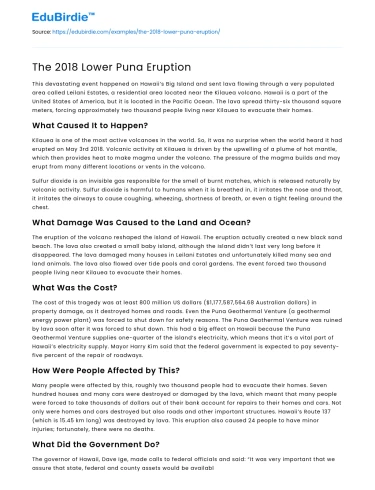This devastating event happened on Hawaii’s Big Island and sent lava flowing through a very populated area called Leilani Estates, a residential area located near the Kilauea volcano. Hawaii is a part of the United States of America, but it is located in the Pacific Ocean. The lava spread thirty-six thousand square meters, forcing approximately two thousand people living near Kilauea to evacuate their homes.
What Caused It to Happen?
Kilauea is one of the most active volcanoes in the world. So, it was no surprise when the world heard it had erupted on May 3rd 2018. Volcanic activity at Kilauea is driven by the upwelling of a plume of hot mantle, which then provides heat to make magma under the volcano. The pressure of the magma builds and may erupt from many different locations or vents in the volcano.
Save your time!
We can take care of your essay
- Proper editing and formatting
- Free revision, title page, and bibliography
- Flexible prices and money-back guarantee
Sulfur dioxide is an invisible gas responsible for the smell of burnt matches, which is released naturally by volcanic activity. Sulfur dioxide is harmful to humans when it is breathed in, it irritates the nose and throat, it irritates the airways to cause coughing, wheezing, shortness of breath, or even a tight feeling around the chest.
What Damage Was Caused to the Land and Ocean?
The eruption of the volcano reshaped the island of Hawaii. The eruption actually created a new black sand beach. The lava also created a small baby island, although the island didn’t last very long before it disappeared. The lava damaged many houses in Leilani Estates and unfortunately killed many sea and land animals. The lava also flowed over tide pools and coral gardens. The event forced two thousand people living near Kilauea to evacuate their homes.
What Was the Cost?
The cost of this tragedy was at least 800 million US dollars ($1,177,587,564.68 Australian dollars) in property damage, as it destroyed homes and roads. Even the Puna Geothermal Venture (a geothermal energy power plant) was forced to shut down for safety reasons. The Puna Geothermal Venture was ruined by lava soon after it was forced to shut down. This had a big effect on Hawaii because the Puna Geothermal Venture supplies one-quarter of the island’s electricity, which means that it’s a vital part of Hawaii’s electricity supply. Mayor Harry Kim said that the federal government is expected to pay seventy-five percent of the repair of roadways.
How Were People Affected by This?
Many people were affected by this, roughly two thousand people had to evacuate their homes. Seven hundred houses and many cars were destroyed or damaged by the lava, which meant that many people were forced to take thousands of dollars out of their bank account for repairs to their homes and cars. Not only were homes and cars destroyed but also roads and other important structures. Hawaii’s Route 137 (which is 15.45 km long) was destroyed by lava. This eruption also caused 24 people to have minor injuries; fortunately, there were no deaths.
What Did the Government Do?
The governor of Hawaii, Dave Ige, made calls to federal officials and said: “It was very important that we assure that state, federal and county assets would be available to keep residents safe”. Donations could be made to a number of organizations like the American Red Cross Hawaii Chapter and the American Red Cross so they could buy essentials for the locals. Emergency crews said they were poised to evacuate more people as fissures kept spreading near the volcano.
What Technology Did They Use?
NASA used it’s Terra satellite to capture a glimpse of the ash plume drifting from the volcano. The satellite captured the image by using its multi-angle imaging spectroradiometer (MISR) instrument. Another instrument/piece of technology they used is a seismometer, it is used for predicting volcanic eruptions anywhere around the world. Volcanologists set many of them up in places that are known to have frequent volcanic activity like Hawaii.
And Finally, Are There Any Building Specifications, Planning or Materials that Could Reduce the Impact of This Disaster?
Unfortunately, there isn't anything that can prevent the lava from damaging houses, buildings, homes, towns, oceans and much more, as it will destroy anything in its path by burning it until it melts. It's liquid rock, so it is heavy, sticky and moving underground. Lava has the ability to melt anything in its path because it is 700-1200 degrees Celsius.






 Stuck on your essay?
Stuck on your essay?

